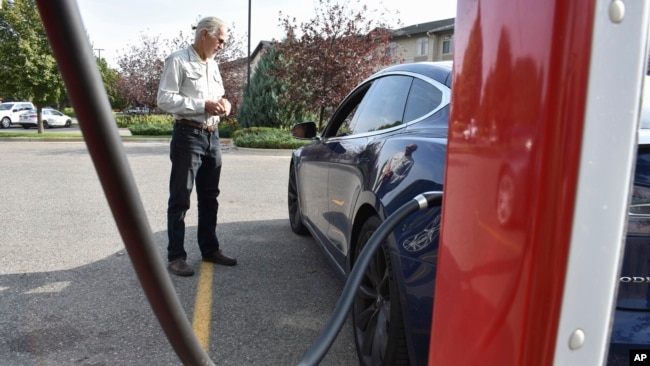広い国土、大型車好きの国民性、だから北米ではまだまだガソリン車が好まれるとギリギリまで販売確保を目論んでいた、日本のメーカーにはアメリカの自動車規制が一気に進むこの現状に戸惑っているのではないでしょうか。
方針を決めたら一気に資金が投じられる。
羅針盤たるリーダー不在の日本では、方針すら迷走し決められない。
難しい単語は出てきてません、気楽にLet't listen!!
VOAで英語を学びましょう!!
米国、高速道路での電気自動車充電ネットワークを構築へ(和訳)
US to Build Highway Electric Vehicle Charging Network
September 29,2022
米国運輸省はこのほど、全米50州の高速道路沿いに電気自動車、EV、用の充電ステーションを建設する計画を承認しました。
充電ステーションのネットワークは、より多くのアメリカ人がゼロ・エミッション車に移行できるようにするための政府の取り組みの一環です。
今回の承認により、充電スタンドの建設に5年間で50億ドルの連邦資金が投入されることになります。ステーションは高速道路に沿って約80キロメートルおきに設置される予定です。目標は、全米で約50万基の充電ステーションを設置することで、2023年の春までには、ステーションの建設が始まる可能性があります。
運輸省の規則では、各州はまず4万ドルから10万ドルの費用がかかる急速充電ステーションを建設しなければなりません。自動車は、このステーションで1時間ほどでフル充電できます。
ピート・ブッティギーグ運輸長官は、「アメリカは前世紀にオリジナルの自動車革命を主導しました」と述べ、この計画により、国内のあらゆる地域の人々が電気自動車を利用できるようになると語っています。
バイデン大統領は、2030年までに米国の新車販売の50%を電気自動車にするという目標を掲げています。充電ネットワークは、アメリカ人が電気自動車を充電する場所を探す心配を減らすための大きな一歩です。しかし、州によっては、限られた電力網の容量やステーションを建設するための資材の不足に対処するのが難しいかもしれません。
テキサス、カリフォルニア、フロリダなどの州は、100万台以上のEVの増加に対応できる電力網が必要だと言います。
しかし、ニュージャージー、バーモント、ミシシッピといった州は、そうとは言い切れません。また、アメリカ製の規則に適合する充電ステーションを設置できるかどうかについても懸念を表明しています。
「導入が数年遅れるかもしれない」とニュージャージー州の担当者は、書いています。
現在、多くのEV所有者は、約80%の割合で、一戸建て住宅で充電しています。しかし、新しい充電ネットワークによって、それは変わりそうです。新法はまた、地方や貧しい地域に充電ステーションを建設するために、25億ドルを追加で支給します。
US to Build Highway Electric Vehicle Charging Network
The U.S. Department of Transportation recently approved plans for all 50 American states to build charging stations for electric vehicles, or EVs, along the nation’s highways.
The network of charging stations is part of the government’s efforts to help more Americans move to zero-emission vehicles.
The approval means that $5 billion in federal money will be available over five years to build the stations. They will be placed about every 80 kilometers along the highways. The goal is to have about 500,000 charging stations across the nation. And construction of the stations could begin by spring of 2023.
Under the Department of Transportation rules, states must first build fast-charging stations that could cost between $40,000 to $100,000. A vehicle can fully charge at these stations in about one hour.
Transportation Secretary Pete Buttigieg said, “America led the original automotive revolution in the last century,” and he said the plan will help make sure people in every part of the country will be able to use electric vehicles.
President Biden has set a goal that 50 percent of new U.S. car sales be electric by 2030. The charging network is a big step to help Americans worry less about finding a place to charge their electric vehicles. But it could be difficult for some states to deal with limited electricity grid capacity and shortages of materials to build the stations.
States like Texas, California and Florida say their electricity grid should be able to handle an increase of a million or more EVs.
Other states like New Jersey, Vermont and Mississippi are not so sure. They also expressed concerns about whether they could set up charging stations that meet the American-made rules.
“It may delay implementation by several years,” New Jersey officials wrote.
Currently, many EV owners charge their vehicles at home, about 80 percent of the time, usually at single-family houses. But that is likely to change with the new charging network. The new law also gives an extra $2.5 billion to rural areas and poorer communities to help build charging stations in those places.
Words in This Story
emission –n. that which is produced or sent out (such as energy or gas) from a source
construction –n. the act of building something, such as a house, road, bridge, and the like
revolution –n. an important change in an area of human activity
grid –n. a network, usually to distribute electricity over an area
capacity –n. the amount of what can be produced or delivered
implementation –n. the act of using or completing a method or project

